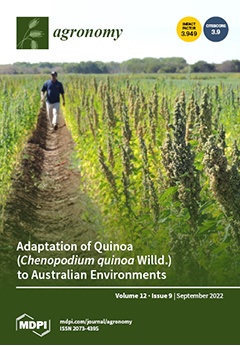Ver ítem
- xmlui.general.dspace_homeCentros Regionales y EEAsCentro Regional Buenos Aires SurEEA Hilario AscasubiArtículos científicosxmlui.ArtifactBrowser.ItemViewer.trail
- Inicio
- Centros Regionales y EEAs
- Centro Regional Buenos Aires Sur
- EEA Hilario Ascasubi
- Artículos científicos
- Ver ítem
Enhancing Sustainability in Intensive Dill Cropping: Comparative Effects of Biobased Fertilizers vs. Inorganic Commodities on Greenhouse Gas Emissions, Crop Yield, and Soil Properties
Resumen
The treatment and valorization of organic solid waste has become a promising alternative to increase intensive crop productivity while reducing its environmental impact. Currently, reusing improved organic waste as novel biofertilizers is a vital tool to adapt semiarid agricultural regions to climate change, but this has been scarcely studied in aromatic crops. The present study aims to assess the greenhouse gas emissions, soil properties, and crop yield
[ver mas...]
The treatment and valorization of organic solid waste has become a promising alternative to increase intensive crop productivity while reducing its environmental impact. Currently, reusing improved organic waste as novel biofertilizers is a vital tool to adapt semiarid agricultural regions to climate change, but this has been scarcely studied in aromatic crops. The present study aims to assess the greenhouse gas emissions, soil properties, and crop yield of a dill crop using a drip irrigation system with a normalized N application rate of 160 kg N ha−1. We compare eight different fertilizing scenarios grouped into organic-based (manures and compost) and inorganic-based inputs (NPK commodities and slow-release formulations). GHG fluxes were measured during the 57-day fertigation period using static chambers. Key soil properties were measured previous to fertilizer applications and at harvest, coinciding with crop yield estimations. An increase in soil organic carbon was observed with stabilized organic treatments at 0–20 cm soil depth. The results show that stabilized organic-based materials lowered NO3− concentrations in dill biomass more than synthetic fertilizers, producing similar yields to those with synthetic fertilizers. In general, N2O emissions were positively affected by the treatments. Local specific emission factors for N2O were determined (0.08%), which were substantially lower than the default value (0.51%) of IPCC. The cumulative CO2 emissions were high in all the organic scenarios compared to the control treatment (277 kg C-CO2 ha−1), probably due to differences in labile organic C contents. Organic-based treatments showed multiple positive effects on crop quality, crop yields, and GHG mitigation potential. The use of organic amendments is an optimized N fertilizing strategy to promote circular economy and sustainability.
[Cerrar]

Autor
Martínez-Sabater, Encarnación;
Pérez-Murcia, María Dolores;
Andreu-Rodríguez, Francisco Javier;
Orden, Luciano;
Agulló, Enrique;
Sáez-Tovar, José;
Martínez-Tome, Juan;
Bustamante, María Ángeles;
Moral, Raúl;
Fuente
Agronomy 12 (9) : 2124 (September 2022)
Fecha
2022
Editorial
MDPI
ISSN
2073-4395
Formato
pdf
Tipo de documento
artículo
Palabras Claves
Derechos de acceso
Abierto
 Excepto donde se diga explicitamente, este item se publica bajo la siguiente descripción: Creative Commons Attribution-NonCommercial-ShareAlike 2.5 Unported (CC BY-NC-SA 2.5)
Excepto donde se diga explicitamente, este item se publica bajo la siguiente descripción: Creative Commons Attribution-NonCommercial-ShareAlike 2.5 Unported (CC BY-NC-SA 2.5)


